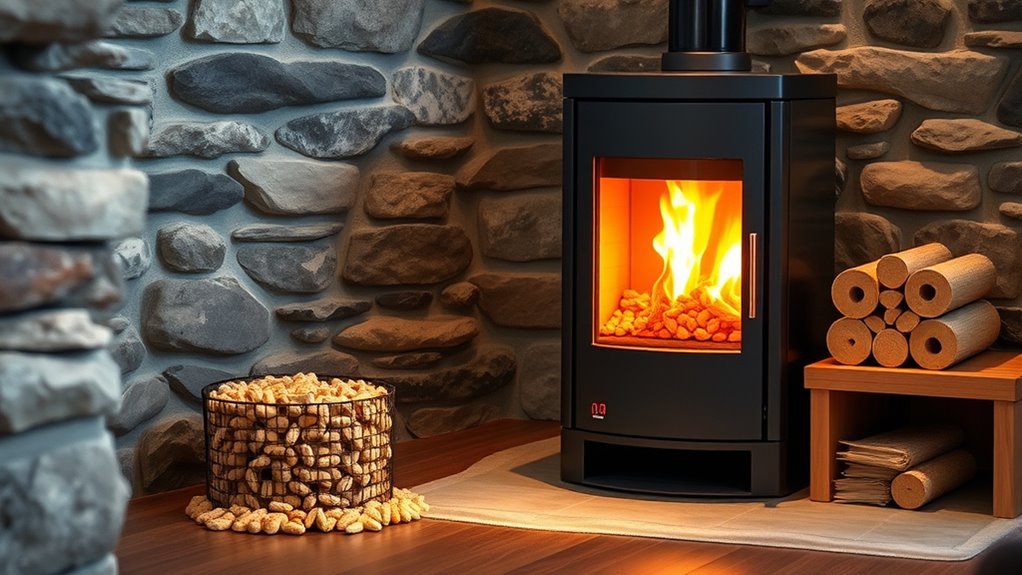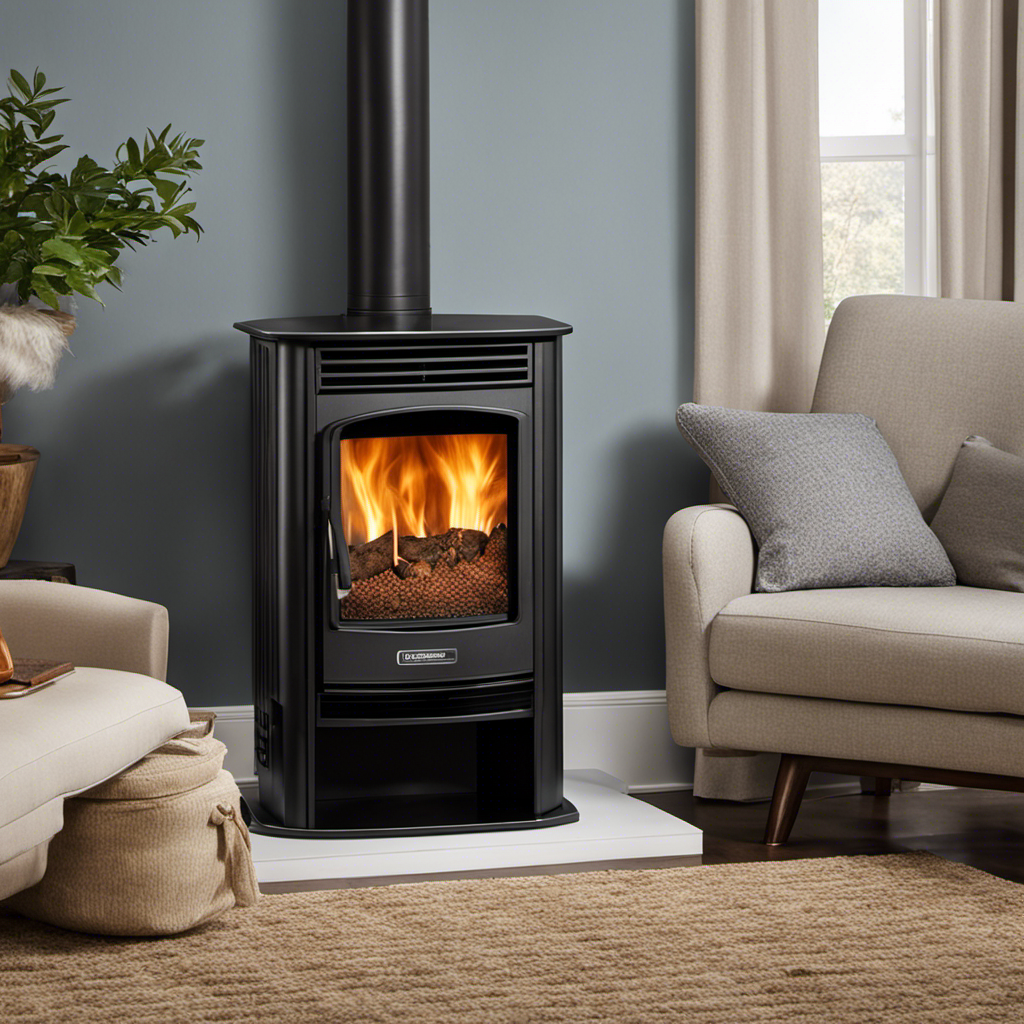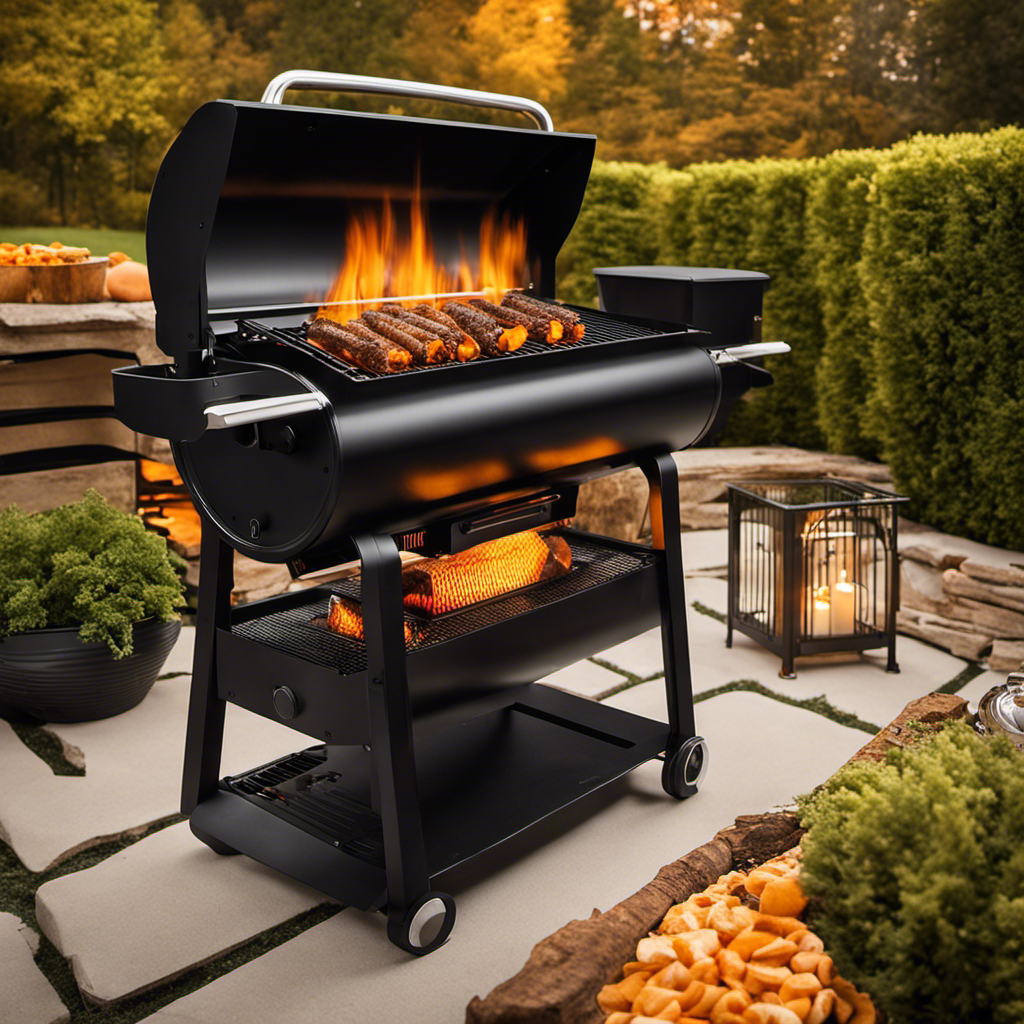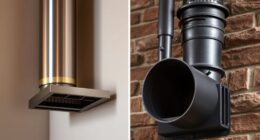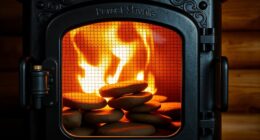Pellet stoves heat your home by burning compressed biomass pellets stored in a hopper, automatically feeding fuel into a burn pot controlled by an electric system. They come in freestanding or insert styles and offer efficient, eco-friendly warmth with minimal maintenance. Proper installation, venting, and regular cleaning are key for safe operation and longevity. If you want to understand how these systems work, their benefits, and how to choose the right one, keep exploring this guide.
Key Takeaways
- Pellet stoves burn compressed biomass pellets for efficient, automated heating with components like hoppers, augers, and burn pots.
- They come in various styles, capacities, and sizes, suitable for different room sizes and home layouts.
- Benefits include low maintenance, eco-friendliness, and consistent heat control, but they rely on electricity and require regular upkeep.
- Proper installation with correct venting and safety measures is essential for optimal performance and safety.
- Regular cleaning and maintenance extend stove lifespan and ensure safe, efficient operation.
What Is a Pellet Stove and How Does It Work
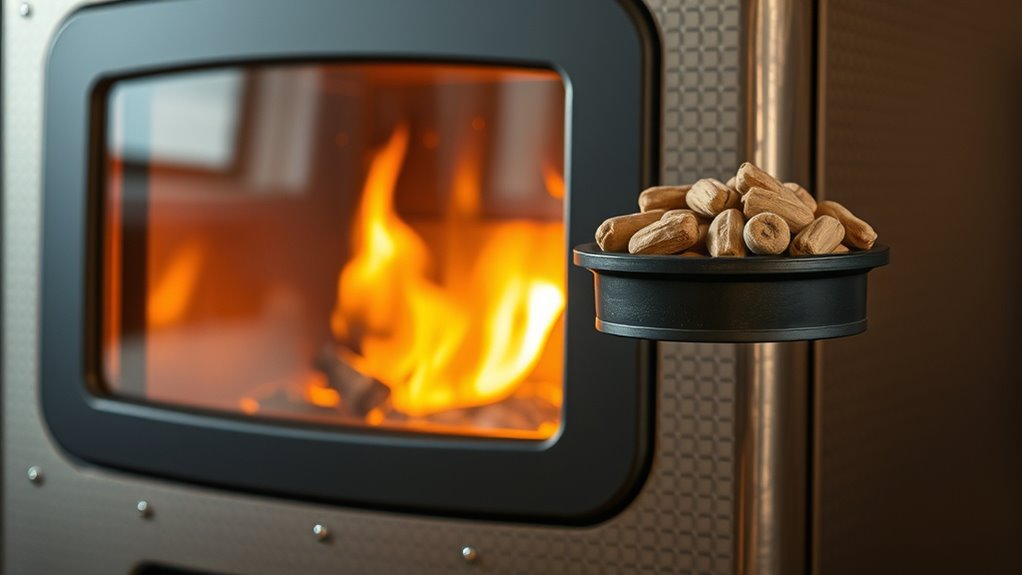
A pellet stove is a heating appliance that burns compressed wood or biomass pellets to produce warmth efficiently. Inside, the hopper stores pellets, which are fed into the burn pot by an electric auger for combustion. As the pellets burn, the stove generates heat to warm your space. The combustion process creates ash, which falls into an ash tray for easy removal. The stove’s thermostat controls the pellet feed, maintaining a steady temperature without constant attention. Unlike traditional wood stoves, a pellet stove offers automated operation, providing consistent, long-lasting heat with less maintenance. The visible flame adds a cozy ambiance, making it both a practical and attractive heating option. Overall, it combines efficient combustion with simple, automated heating management.
Key Components of Pellet Heating Systems

Understanding the key components of pellet heating systems helps you appreciate how they operate efficiently and safely. The fuel hopper stores compressed wood or biomass pellets, providing several days of fuel. An electric auger automatically transports pellets from the hopper to the burn pot, where combustion occurs. The burn pot is the heart of the stove, igniting the pellets to produce heat. The heat exchange system transfers this heat to your room, often using a blower or convection fan to circulate warm air. An ash pan collects unburned residues, requiring periodic cleaning to maintain efficiency. Control boards and thermostats regulate pellet feed rates and temperature, ensuring consistent heat and safe operation. These components work together seamlessly to deliver reliable, efficient heating. Additionally, many systems incorporate safety features to prevent malfunctions and ensure user safety during operation. Proper system maintenance is essential for optimal performance and longevity of your pellet stove. Regular inspections of components like the heat exchange system can help prevent issues before they affect operation.
Different Types of Pellet Stoves
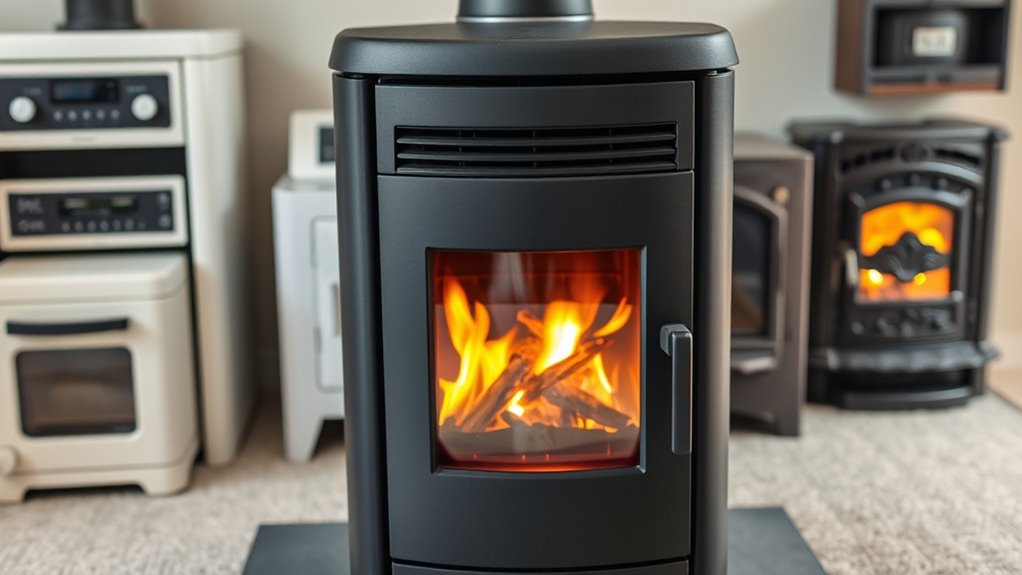
When choosing a pellet stove, you’ll notice options like freestanding models and inserts designed to fit into existing fireplaces. Each type offers different styles and capacities, affecting how much heat they can provide and where they work best. Understanding these differences helps you pick the right stove for your home’s layout and heating needs. Additionally, considering Vetted appliances ensures you select high-quality, reliable options that meet safety standards. Opting for appliances with certified safety features can provide added peace of mind and ensure compliance with safety regulations. Researching brands with positive customer reviews can also help confirm the stove’s effectiveness and trustworthiness. Exploring various models can help identify features that best suit your specific space and preferences. Being aware of trademark protections can also assist you in selecting reputable brands that prioritize quality and legal compliance in their manufacturing processes.
Insert vs. Freestanding Models
Choosing between insert and freestanding pellet stoves depends on your home’s layout and heating needs. An insert pellet stove fits into your existing fireplace, offering a seamless upgrade with minimal installation work. It’s ideal if you want to preserve your fireplace’s appearance while improving efficiency. Venting is usually straightforward, often through the chimney you already have. On the other hand, a freestanding pellet stove is a standalone unit that can be placed anywhere in your home, providing greater flexibility in placement. These models typically have larger heat outputs, making them suitable for heating bigger spaces or multiple rooms. However, installation might require new venting systems. Both options enhance your home’s heating, but your choice hinges on your specific space and preferences. Proper venting is crucial for maintaining safety and efficiency with both types of stoves. Additionally, selecting the right model can influence your overall cost and budgeting, ensuring you make a financially sound decision. Regular maintenance and understanding your heating system’s performance capabilities can also help maximize efficiency and lifespan.
Styles and Design Options
Pellet stoves come in a variety of styles and designs to suit different home aesthetics and functional needs. Whether you prefer a traditional look or a sleek, modern feel, there’s a stove style for you. For example, fireplace inserts seamlessly integrate into existing fireplaces, enhancing both decor and efficiency. Modern pellet stoves often feature glass doors, offering a view of the flames and creating ambiance. Customizable exteriors allow you to match your stove to your home decor perfectly. Here’s a quick visualization:
| Style | Design Features | Suitable For |
|---|---|---|
| Traditional | Cast-iron finishes, decorative details | Classic homes |
| Modern | Sleek lines, glass doors | Contemporary spaces |
| Fireplace Insert | Fits into existing fireplaces | Space-saving needs |
| Compact | Small size, efficient heating | Small rooms |
Additionally, understanding the design options available can help you select a pellet stove that complements your interior style and meets your heating requirements. Exploring different styles and designs can also improve energy efficiency and aesthetic harmony in your home. For instance, selecting the right pellet stove material can influence durability and maintenance needs.
Capacity and Heating Range
Selecting the right pellet stove depends on its capacity to effectively heat your space. BTUs measure the heat output, and the heating range varies based on capacity, size, and insulation. Small pellet stoves, with 8,000 to 20,000 BTUs, are perfect for single rooms or small spaces, typically heating up to 500 square feet. Medium-sized models, producing 20,000 to 40,000 BTUs, can handle larger areas or open floor plans, reaching about 1,000 to 2,000 square feet. Large pellet stoves, exceeding 40,000 BTUs, are suitable for whole-house heating or large, spacious homes. Consider your room size, insulation quality, and desired heat output to choose a stove with the appropriate capacity and heating range for your needs.
Benefits of Choosing a Pellet Stove
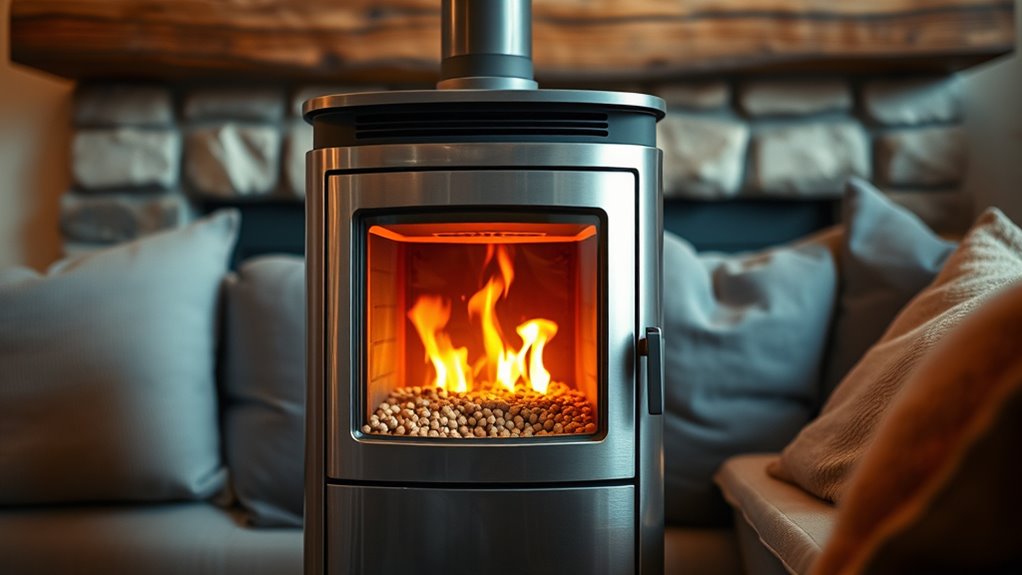
One of the biggest advantages of pellet stoves is their high efficiency, often reaching up to 90%, which can substantially lower your heating costs. Their efficiency means you get more heat from less fuel, saving you money over time. Made from renewable, recycled wood waste, pellet stoves are environmentally friendly, producing minimal emissions and reducing your carbon footprint. They generate low ash, making cleanup easier and less frequent. With automatic operation and thermostatic controls, you enjoy steady, consistent heat without constant manual adjustments. Installation costs are relatively low, and maintenance is simpler compared to traditional wood stoves. Additionally, their use of sustainable resources supports environmental sustainability and responsible forestry practices. Modern pellet stoves often incorporate digital controls that allow for precise temperature management and remote operation, further enhancing user convenience. Regular use of self-understanding can help you better appreciate the benefits of eco-friendly heating options. Recognizing the efficiency of pellet stoves can lead to better energy management in your home. Overall, choosing a pellet stove offers an efficient, eco-conscious, and cost-effective way to keep your home warm while minimizing effort and environmental impact.
Potential Drawbacks to Be Aware Of
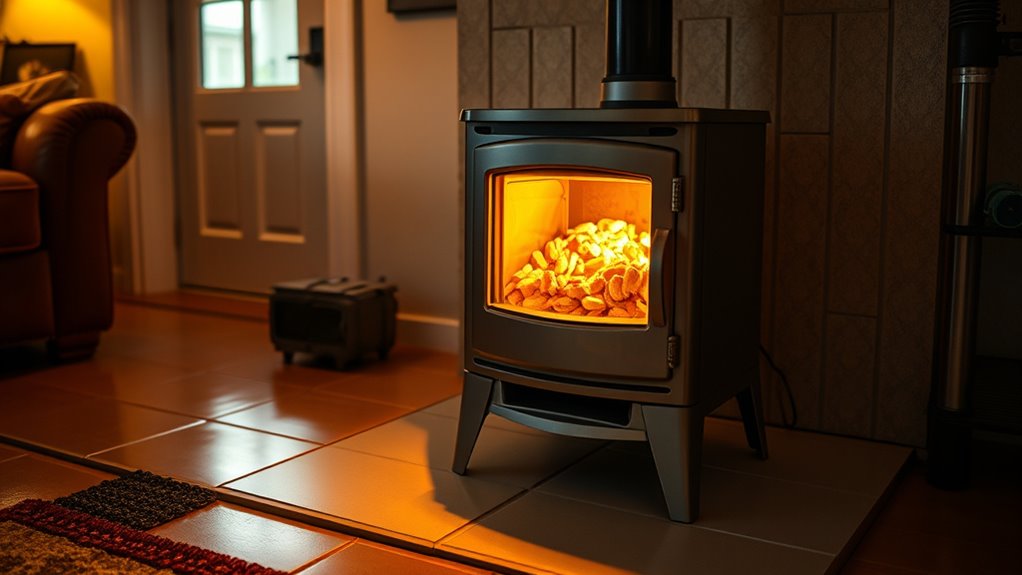
While pellet stoves offer many benefits, there are important drawbacks to contemplate. They depend on electricity to operate fans, augers, and controls, so power outages can stop your stove unless you have a backup. Regular maintenance, including ash removal and vent cleaning, is essential to prevent safety hazards and keep it running efficiently. Proper fuel storage is essential; moisture in pellets can cause feed issues and reduce fuel quality. The initial installation cost, ranging from $1,015 to $3,594, can be a significant expense. Managing fuel storage and ongoing pellet costs might also be inconvenient. Additionally, energy dependence requires reliable power sources for optimal operation. Be aware of these potential challenges to make an informed decision about whether a pellet stove fits your household needs. Regular monitoring of pellet quality can help ensure consistent performance and safety. Keeping an eye on ventilation requirements is also crucial to avoid buildup of harmful gases and ensure proper airflow. In addition, understanding energy efficiency can help you evaluate long-term savings and environmental impact. Staying informed about AI security developments can also help you recognize emerging safety challenges associated with modern technology.
Selecting the Right Size and Capacity for Your Home
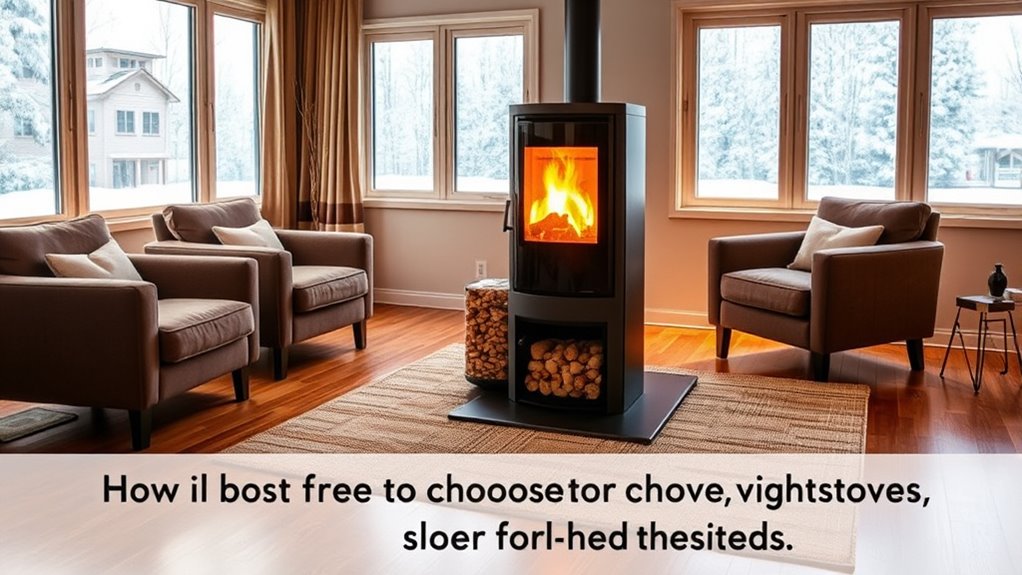
To choose the right pellet stove, start by evaluating your home’s size and heating needs, including insulation and climate. Make certain the stove’s capacity ratings match or slightly exceed your calculated BTUs for consistent warmth. Also, consider the hopper size to ensure it suits your household’s burn time requirements. Additionally, exploring tuning options for your stove can optimize performance and efficiency over time. Regular maintenance and understanding your stove’s performance metrics can further enhance longevity and energy efficiency.
Room Size and Heating Needs
Choosing the right pellet stove size begins with measuring your room’s square footage. This helps you determine the appropriate BTU output needed to heat your space effectively. For example, a small room might require a stove with a lower heating capacity, while larger or open areas need higher BTU ratings. Keep in mind that your home’s insulation and ventilation influence heating needs—poor insulation or high ventilation can increase your requirements. To visualize, consider these points:
- A cozy living room with thick insulation needs less BTU output
- An open-concept area may require a stove with higher heating capacity
- Ventilation levels impact how much heat your stove must produce for comfort
Matching your home size with the correct stove ensures efficient, consistent warmth without overworking the unit.
Pellet Stove Capacity Ratings
Selecting the right pellet stove capacity is essential for efficient heating and energy use. Your stove’s heating capacity, measured in BTUs, determines how well it can warm your space. For example, a 24,000 BTU stove typically heats about 1,200 to 1,500 square feet, but factors like insulation and climate influence this. To find the right stove size, use sizing guides or BTU calculators provided by manufacturers, considering your home’s insulation quality, window efficiency, and square footage. An oversized stove can cause inefficient burning and excess ash, while an undersized one may struggle to maintain consistent warmth. Proper sizing guarantees ideal performance and fuel efficiency, making your heating system both effective and economical.
Proper Installation and Venting Guidelines
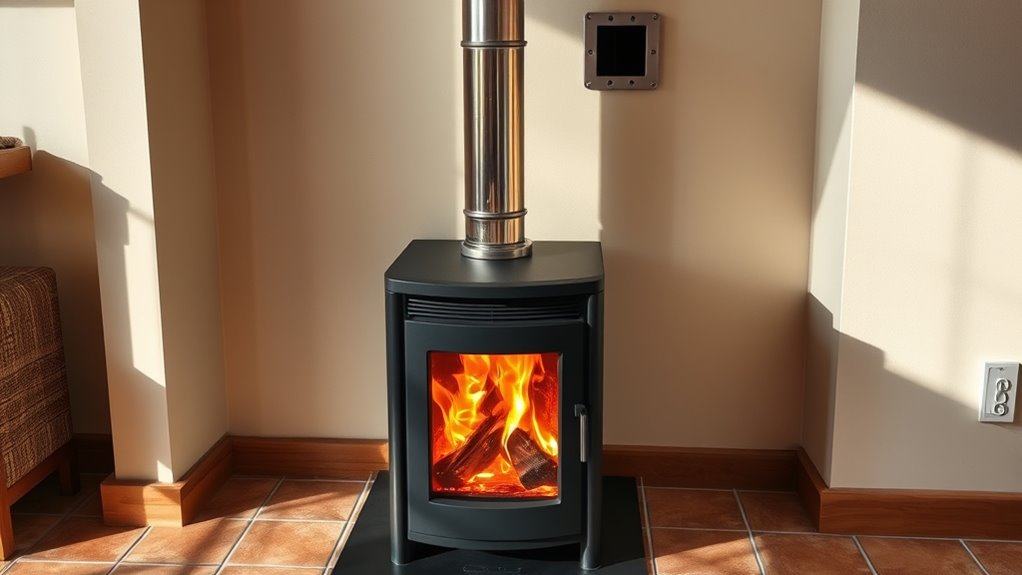
Proper installation of a pellet stove is vital for safe and efficient operation, and it must comply with local building codes. You should guarantee proper *installation* by maintaining clearances—typically 12 to 36 inches from combustible materials—according to your stove’s specifications. The *venting* system must be sealed tightly to prevent leaks, whether through horizontal pipes exiting the wall or a vertical *chimney* through the roof, to safely exhaust gases. Most installations require a dedicated outside air intake for ideal combustion. To avoid hazards, you’ll need to obtain *permits* and have a professional handle electrical connections, venting, and fuel supply. Proper *venting* prevents dangerous exhaust leaks, carbon monoxide buildup, and stove inefficiency. Following manufacturer guidelines and local regulations is essential for safety and performance.
Understanding Pellet Types and Quality Standards
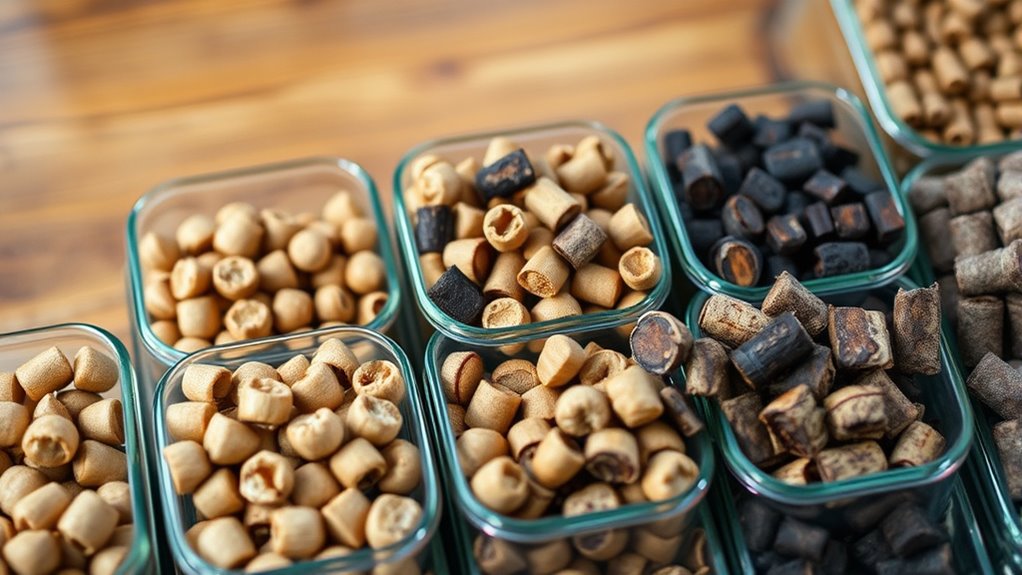
Understanding pellet types and quality standards is essential for maximizing your stove’s performance and minimizing maintenance. Pellets are made from compressed wood waste, mainly sawdust, and come in hardwood, softwood, or blended varieties. High-quality pellets have less than 1% ash content and a moisture level of 5-10%, resulting in cleaner burning and less buildup. The Pellet Fuels Institute grades pellets into premium, standard, and utility categories, with premium offering the best performance and lowest ash. Hardwood pellets, like oak and maple, burn longer and hotter, while softwood pellets, such as pine and fir, are usually less expensive but burn faster. Choosing the right pellet types and quality guarantees efficient operation, less ash, and reduces your stove’s maintenance needs.
Maintenance and Cleaning Practices for Longevity
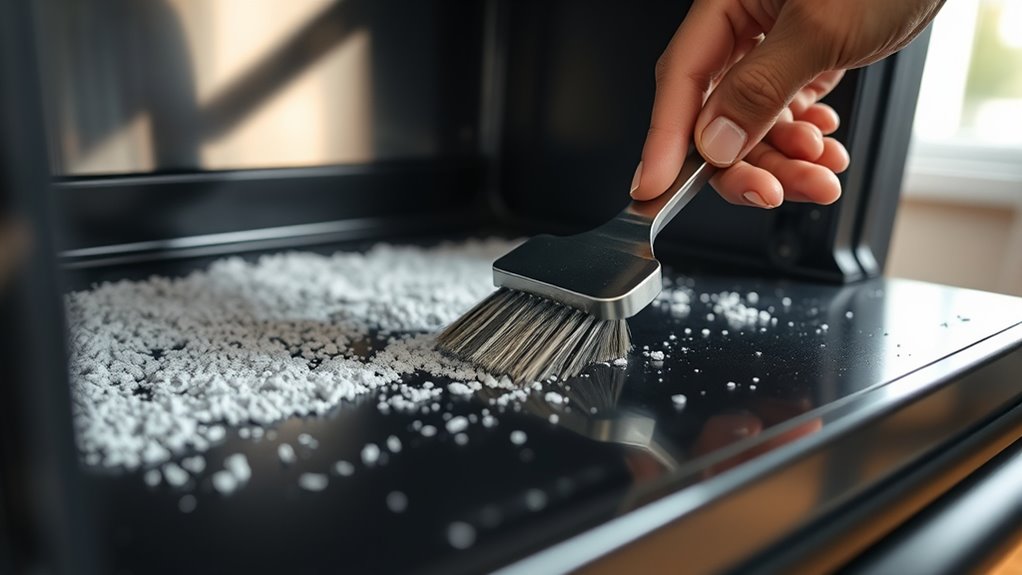
Keeping your pellet stove in top shape requires a regular cleaning schedule and proper ash disposal. By routinely removing ashes and scraping the burn pot, you help guarantee efficient fuel combustion and prevent clogs. Consistent maintenance not only extends your stove’s lifespan but also keeps it running safely and smoothly.
Regular Cleaning Schedule
To guarantee your pellet stove operates efficiently and lasts longer, establishing a regular cleaning schedule is essential. Consistent ash removal prevents buildup and keeps airflow ideal, while daily scraping of the burn pot removes clinker and residue for steady pellet combustion. Weekly cleaning of the pellet stove glass with a damp cloth keeps the viewing window clear and enjoyable. Additionally, inspecting and cleaning the heat exchanger and venting system annually helps prevent blockages and ensures safe operation. Remember to schedule a professional stove maintenance and chimney sweep at least once a year to extend your stove’s lifespan and maintain peak efficiency.
- Regularly empty the ash pan to avoid clogging and improve airflow
- Scrape the burn pot daily to remove clinker and residue
- Schedule annual chimney sweep and heat exchanger cleaning
Proper Ash Disposal
Proper ash disposal is essential for maintaining your pellet stove’s safety and efficiency. Regularly remove ashes from the ash pan at least weekly to prevent ash buildup, which can hinder proper airflow and stove performance. Use a metal scoop or a vacuum designed for ash removal to safely handle cooled ashes, avoiding dust and health hazards. Dispose of ashes in a metal container with a tight lid, and store it outdoors away from combustible materials to prevent fire risks. Make sure to scrape the burn pot daily to remove clinker and residue, supporting efficient combustion and minimizing ash accumulation. Incorporate regular stove cleaning practices, including emptying the ash container, to keep your pellet stove operating smoothly and extend its lifespan.
Tips for Buying and Storing Pellets Effectively

Choosing the right pellets and storing them properly can substantially impact your stove’s performance. To guarantee ideal pellet quality, keep them in a dry, indoor storage area away from walls and damp spots. Use airtight containers or tightly sealed bags to provide moisture protection and prevent spoilage. Store pellets off the ground on pallets or shelves to avoid moisture absorption. Regularly check for signs of mold or swelling, and keep the storage area clean and well-ventilated. Buying from reputable suppliers that meet quality standards, such as those set by the Pellet Fuels Institute, helps assure consistent performance. Consider purchasing smaller quantities to maintain freshness and reduce waste. Proper pellet storage enhances efficiency and prolongs the lifespan of your stove.
Frequently Asked Questions
What to Know Before Buying a Pellet Stove?
Before buying a pellet stove, you need to get your ducks in a row. Know your home’s size and insulation to pick the right capacity. Choose high-quality pellets with low ash and moisture for smooth operation. Check power needs and backup options, and consider installation costs. Look for features like automatic feeds and thermostats to match your comfort, ensuring you’re not jumping in without all the facts.
How Long Will a 40 Lb Bag of Wood Pellets Burn?
A 40-pound bag of wood pellets typically burns for about 20 to 40 hours, depending on your stove’s heat setting and efficiency. At moderate heat, you might get closer to 30-40 hours, while higher settings will reduce that to around 20 hours. Factors like pellet quality, stove model, and insulation can also affect burn time. Using good pellets and maintaining your stove helps maximize how long your bag lasts.
How to Use a Pellet Stove for Beginners?
To use a pellet stove as a beginner, start by reading the manual to understand your model’s features. Fill the hopper with dry pellets, avoiding overfill. Turn on the stove, set your desired temperature, and let it automatically manage feeding and combustion. Regularly clean the burn pot, glass, and ash pan, and keep backup power options handy for outages. With practice, you’ll keep your stove running smoothly and safely.
Why Are People Getting Rid of Pellet Stoves?
They say, “Out with the old, in with the new,” and that’s why many are ditching pellet stoves. You might find them unreliable during power outages, and keeping up with maintenance can be a hassle. Plus, the cost and effort of storing pellets add up. As newer, more efficient heating options emerge and environmental concerns grow, folks are choosing alternatives over traditional pellet stoves to stay cozy and save time.
Conclusion
Choosing a pellet stove is like planting a seed for cozy, efficient warmth in your home. By understanding how it works, selecting quality pellets, and following proper maintenance, you’ll enjoy reliable heat all season long. Just as a well-tuned instrument produces beautiful music, a well-maintained stove offers smooth operation and peace of mind. Embrace the knowledge, and your investment will reward you with comfort that’s as steady as the sunrise.

